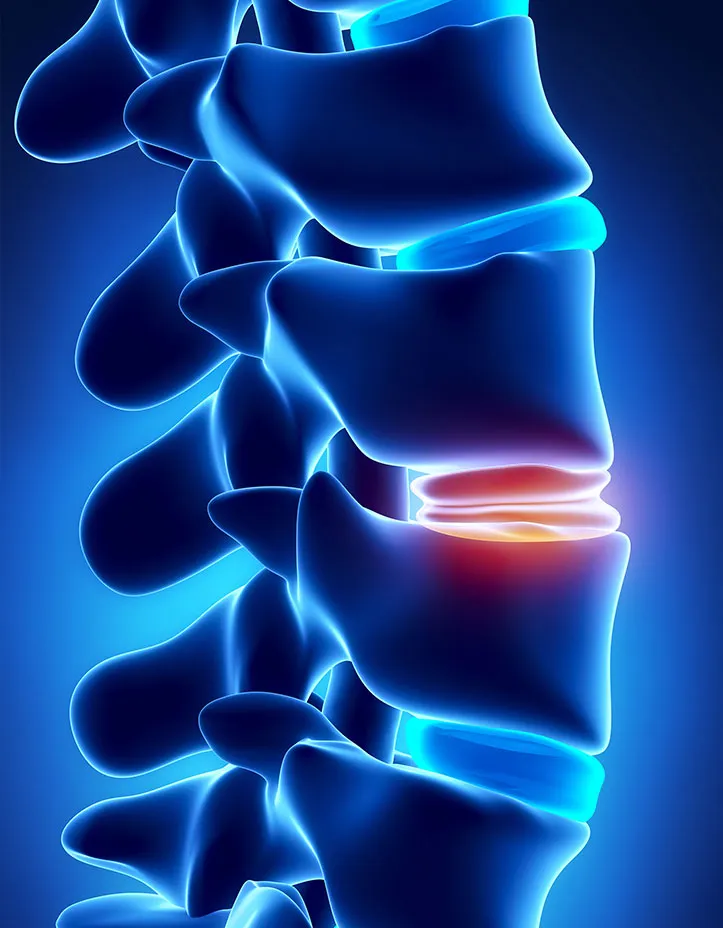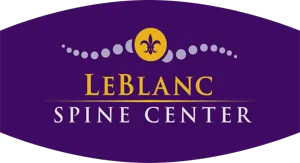Spinal Decompression Therapy
If you're struggling with back pain, herniated discs, or other spinal issues, our specialized spinal decompression therapy offers a gentle, non-invasive solution to your problem.


What is Spinal Decompression Therapy?
Spinal Decompression Therapy is a non-surgical treatment designed to relieve pressure on the spine and alleviate pain caused by conditions such as herniated discs, sciatica, and degenerative disc disease. During the therapy, a specialized table gently stretches the spine, creating space between the vertebrae. This process helps to improve blood flow, promote healing, and can assist in repositioning bulging discs. Patients typically lie on the table while the device applies controlled traction, which may feel gentle and relaxing. The therapy aims to decrease pressure on the spinal nerves and surrounding tissues, providing relief from discomfort and enhancing mobility. Sessions are usually conducted over a series of visits, and many patients report feeling improvements in their pain levels and overall function. It’s important to consult a healthcare professional to determine if this treatment is suitable for your specific condition.
People choose spinal decompression therapy for various reasons, primarily to alleviate chronic pain and discomfort associated with conditions like herniated discs, sciatica, and degenerative disc disease. This non-invasive approach offers patients the opportunity to regain lost mobility, enabling them to return to their daily activities, including work, more swiftly. Many individuals seek this therapy to avoid the side effects and potential dependencies linked to pain medications, as well as to steer clear of more invasive procedures like surgery and injections. By providing a gentle and effective relief mechanism, spinal decompression helps restore function and enhances the overall quality of life, allowing individuals to enjoy their routines without the constraints of debilitating pain.
What conditions can spinal decompression treat?
Spinal decompression therapy is a non-surgical treatment designed to relieve pressure on the spine and alleviate various conditions. Here are the conditions that spinal decompression can effectively treat:
- Bulging/herniated discs
- Degenerative Disc Disease
- Sciatica
- Arm/Leg Pain and Numbness
- Facet Syndrome
- Failed Back Surgery
- Pinched Nerves
- Chronic Neck or Back Pain that doesn't respond to chiropractic care
- Spinal Stenosis
These conditions often result from pressure on the spinal nerves or discs, causing pain and discomfort. Spinal decompression helps by creating negative pressure in the spinal column, which can facilitate the retraction of herniated discs and promote healing. It is essential to consult with a healthcare professional to determine if spinal decompression is a suitable option for your specific condition.
What are the benefits of spinal decompression?
No Drugs
Experience relief without relying on medications that can have side effects.
No Injections
Eliminate the need for painful injections that often provide only temporary relief.
No Surgery
Avoid invasive surgical procedures and their associated risks.
Physiological Benefits:
- Increases blood flow, improving nutrient supply into the disc
- Decreases intradiscal pressure
- Promotes the regression of disc herniation
- Reduces nerve compression
- Facilitates disc rehydration
Physical Benefits:
- Decreases pain levels
- Improves spinal mobility
- Reduces muscle guarding
- Enhances postural integrity
- Develops core strength
- Increases joint flexibility
- Lowers stress levels
- Boosts the immune system
- Prevents new injuries
- Promotes wellness

Spinal decompression offers a non-invasive method to relieve pain, enhance mobility, and improve overall health, making it a safe and effective option for those suffering from back issues.
Cervical Spine Decompression
Cervical spine decompression is a non-invasive treatment aimed at relieving pressure on the discs and nerves in the neck region. Using a specialized traction table, gentle, targeted stretching is applied to the cervical spine to create negative pressure within the spinal discs. This allows bulging or herniated discs to retract, alleviating pressure on the nerves and reducing pain and discomfort.
- Herniated discs in the neck
- Cervical radiculopathy (nerve pain radiating into the arms)
- Degenerative disc disease in the cervical spine
- Pinched nerves in the neck
- Stiffness and restricted movement in the neck and shoulders
Cervical decompression is typically performed in sessions that last around 30 minutes, and most patients experience relief after a few treatments. This therapy can improve neck mobility, reduce radiating pain, and support long-term neck health.
Lumbar Spine Decompression
Lumbar spine decompression targets the lower back, where issues such as herniated discs, sciatica, and degenerative disc disease are common. This non-surgical treatment uses a traction table to stretch and relieve pressure on the lumbar spine. By creating a vacuum-like effect, spinal discs are able to return to their proper positions, reducing nerve compression and allowing for natural healing.
Conditions commonly treated with lumbar decompression include:
- Sciatica (pain radiating down the leg)
- Herniated or bulging discs in the lower back
- Lower back pain due to degenerative disc disease
- Lumbar radiculopathy (nerve pain radiating from the lower back)
- Spinal stenosis in the lumbar region
Patients usually undergo multiple sessions, each lasting around 30-45 minutes, with a gradual improvement in pain and mobility. Lumbar decompression helps restore proper alignment, reduce inflammation, and promote long-term recovery from chronic lower back pain.
What kind of success does spinal decompression have?
Spinal decompression therapy has gained significant attention in recent years as a non-surgical treatment option for alleviating back pain and promoting spinal health. This therapeutic approach focuses on relieving pressure on the spinal discs and surrounding structures, thereby aiding in the healing process. Many patients report varying degrees of success with spinal decompression, making it essential to understand what outcomes can be expected from the treatment.
Clinical studies have shown that spinal decompression therapy can effectively reduce pain and enhance mobility in individuals suffering from conditions such as herniated discs, degenerative disc disease, sciatica, and lower back pain. The mechanism behind its success lies in the gentle stretching of the spine, which creates a negative pressure within the disc space. This negative pressure can facilitate the retraction of herniated disc material, allowing for a more favorable environment for healing and potentially reducing nerve irritation.
Patient reviews often highlight the immediate relief of symptoms following treatment sessions. Many report a significant reduction in pain levels, with some achieving lasting relief after a series of sessions. In particular, individuals who have not found success with conventional treatments such as medication or physical therapy may experience renewed hope through spinal decompression.
However, the overall success rates can vary depending on various factors. The specific medical condition being treated, the duration and frequency of therapy sessions, and the individual’s overall health and lifestyle all play a role in the outcome. It's crucial for potential candidates to consult with qualified healthcare professionals to assess their individual situations and determine if spinal decompression is a suitable option for them.
In conclusion, spinal decompression therapy offers a promising avenue for many patients seeking relief from back pain. While results can differ, numerous individuals have reported positive effects, making it a valuable tool in the comprehensive management of spinal health. As with any treatment, an informed approach and collaboration with healthcare providers can help maximize the likelihood of success.
How does Spinal Decompression Work?
Spinal decompression is a therapeutic technique designed to alleviate pressure on the spinal discs and surrounding structures, providing relief from pain and discomfort. The treatment can be performed through various methods, including surgical procedures, physical therapy, and non-invasive traction techniques. The fundamental principle behind spinal decompression involves creating negative pressure within the vertebral discs, allowing for improved blood flow, nutrient distribution, and healing of damaged tissues.
Mechanism of Action
When the spine is subjected to stress from daily activities or injuries, the intervertebral discs can become compressed. This compression may lead to conditions such as herniated discs, sciatica, or spinal stenosis. Spinal decompression therapy aims to reverse this compression by gently stretching the spine, which creates a negative pressure that pulls the displaced disc material back into the disc space.
During non-surgical spinal decompression therapy, patients lie on a traction table that gently elongates the spine. This technique helps to increase the space between the vertebrae and can also improve the alignment of the spinal structure. The process enhances the flow of oxygen and nutrients to the discs, promoting healing and reducing inflammation in the surrounding tissues.
Benefits of Spinal Decompression
Patients often report a significant reduction in pain and improvement in mobility following spinal decompression therapy. The treatment can help ease muscle tension, enhance flexibility, and restore a greater range of motion. Additionally, because it is a non-invasive method, many patients prefer it over more invasive surgical options.
In conclusion, spinal decompression offers a holistic approach to treating spinal issues by addressing the root cause of discomfort. By understanding how this therapy works, patients can make informed decisions about their spine health and seek appropriate treatments for their conditions. To find out how spinal decompression can help you, make an appointment with our chiropractors in Baton Rouge or Kenner for a consultation.
Contact us for an Appointment
Fill out the form and we'll give you a call to schedule you.

FAQs
Here are some of the most common questions about spinal decompression treatment, and what to expect during your visits with us.
Non-surgical Spinal Decompression is a non-invasive, breakthrough treatment for acute and chronic back and leg pain or neck and arm pain sufferers. Decompression is highly effective in the management of herniated, ruptured, bulging and degenerative discs. It is safe and effective without the normal risks associated with invasive procedures such as injections or surgery. During the procedure a series of distraction and relaxation phases occur at a very specific angle. A spinal disc can be isolated and a negative pressure(vacuum) can be created inside the disc. Our state of the art technology is FDA cleared and is very successful in relieving pain low back and neck pain sufferers, particularly when other treatments have failed.
During spinal decompression therapy a negative pressure(vacuum) is created within the disc. Because of that negative pressure, disc material that has been herniated can be pulled back within the disc and allow healing to occur.
Anyone who in whole or in part has back or neck pain caused by a damaged disc. These conditions include herniated, protruding or bulging discs, spinal stenosis, sciatica or radiculopathy (pinched nerves).
A typical session of spinal decompression therapy lasts about 30 to 45 minutes.
Improvement can be long-lasting if combined with proper rehabilitation, lifestyle changes, and follow-up care.
The award winning Triton Computer is the difference. It controls the variations in traction pull allowing for spinal decompression, and eliminating muscle pull or guarding that occurs with traditional traction systems. Studies verify the significant reduction of intradiscal pressures in the negative pressure range, to approximately -150mm/HG, which results in the non-surgical decompression of the disc and nerve root. Traditional traction has never demonstrated reduction of intradiscal pressure to negative ranges; on the contrary-many standard traction devices may actually increase intradiscal pressure due to reflex muscle spasm. The DTS Decompression system is designed to apply traction to the patient's spine without eliciting reflex muscle contractions.
YES! There's plenty of research to back up the claims of Spinal Decompression Therapy and its effectiveness. Here are just a few of the published scientific studies......
• “Patients reported a mean 88.9% improvement in back pain and better function...No patient required any invasive therapies (e.g. epidural injections, surgery).” - American Academy of Pain Management
• “We thus submit that decompression therapy should be considered first, before the patient undergoes a surgical procedure which permanently alters the anatomy and function of the affected lumbar spine segment.” - Journal Of Neuroscience Research
• “86% of the 219 patients who completed the therapy reported immediate resolution of symptoms.” - Orthopedic Technology Review
• “Vertebral axial (spinal) decompression was successful in 71% of the 778 cases” - Journal of Neurological Research
• “Good to excellent relief in 86% of patients with Herniated discs” - The American Journal of Pain Management
• “Decompression Therapy reported a 76.5% with complete remission and 19.6% with partial remission of pain and disability” - Rio Grande Hospital, Department of Neurosurgery
Many patients report noticeable improvement within a few sessions, though individual experiences may vary.
DTS Spinal Decompression provides relief to severe back and neck pain sufferers by gently reducing the pressure within spinal discs. The bones of the spine are slowly and methodically separated using the state-of-the-art DTS Spinal Decompression Unit. As the vertebrae are separated pressure is slowly reduced within the disc (intradiscal pressure) until a vacuum is formed. This vacuum “sucks” the gelatinous center of the disc back inside thereby reducing the disc bulge or disc herniation. Significant disc bulge reduction removes pressure off the spinal nerves and drastically reduces pain and disability. This “sucking” vacuum also pulls much-needed oxygen, nutrients and fluid into injured and degenerated discs allowing the healing to begin.
The treatment motion is computer controlled to provide gentle and painless decompression of the injured spinal discs. Advanced DTS decompression techniques separate slowly and cycle between brief moments of pulling and relaxing (oscillation). This reduces protective muscle spasm that contributed to the poor success rate of outdated “traction” techniques. The DTS unit also incorporates advanced angulated elongation methods to target specific discs of the spine (for example: L5/S1 at the base of the spine). “Angulated Elongation” refers to the angle at which the healing decompression force is applied. This allows the treatment to rely less on brute force (separating multiple levels with high force) and more on finesse (using less decompressive force to focus on a single spinal segment) to rehabilitate individual spinal discs.
DTS Spinal Decompression Therapy is a pain-free alternative that has shown a very high rate of success at reducing and even eliminating back and neck pain altogether. If you suffer from chronic, debilitating, low back or neck pain, you owe it to yourself to call our office today to make an appointment to see if you’re a candidate for the DTS Spinal Decompression Therapy.
Our office is dedicated to offering the latest, state-of-the-art therapies for treating pain in the low back and neck, sciatica, pinched nerves, and bulging or degenerative disc diseases. We believe DTS Spinal Decompression Therapy to be the most advanced, non-surgical and pain-free alternative.


